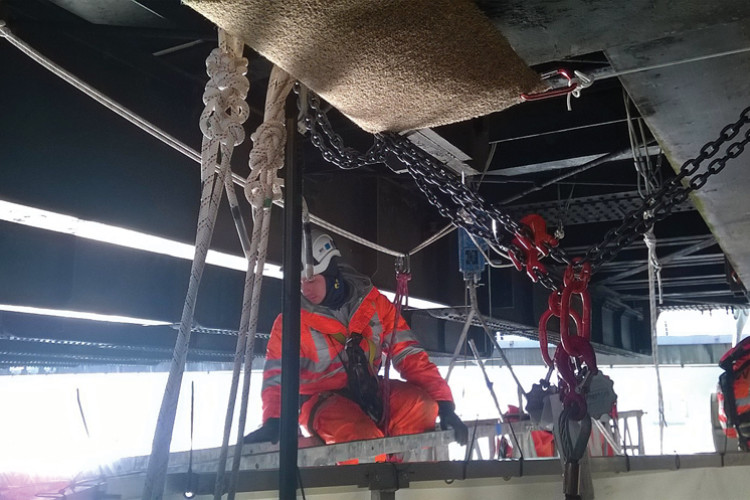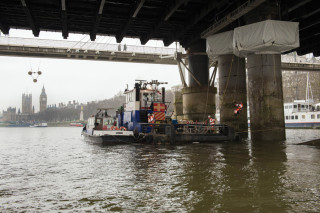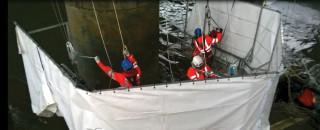Network Rail has hundreds – possibly thousands – of bridges carrying its tracks across rivers. Some are relatively insignificant; others (think of the Forth Bridge) are massive and world-famous. But all of them require regular maintenance.
Nowhere is there a greater concentration of major rail-over-river bridges than in central London and one of them, Hungerford Bridge which carries trains across the Thames and into Charing Cross station, is one of the busiest.
Recent inspections revealed that strikes from passing vessels and vibration induced by trains meant that remedial repair works were required to the piers supporting Hungerford Bridge.
Network Rail therefore had to find a way of carrying out this work efficiently and safely. It was essential that a safe system of work was devised that would minimise disruption to the operational railway and the navigable river channel whilst also eliminating the risk of environmental damage as a result of polluting the watercourse. And of course it was essential that the system would provide safe and easy access for the client’s specialist repair contractor, Metalock, that would be carrying out stitch repairs to the cast iron casing of the piers.
Under the current Network Rail fiveyear control period, the Kent region “multifunctional framework” is managed by Costain; Hungerford Bridge comes within its remit and so Costain has the main contract for these remedial works.
It so happens that one of Costain’s supply chain partners specialising in difficult access for geotechnical, structural and civil engineering projects is Chesterfield-based CAN, which had the task of devising a suitable access solution.
Working in close collaboration with Costain, Metalock and the client, Network Rail, CAN developed a modified version of its patented CAN-Span access cradle with a containment system that encompasses the columns of the piers. It is dubbed the Ring CAN-Span.
CAN-Span is a lightweight modular staging system made up of 2m or 3m units, which can be linked together in different configurations to suit the particular site conditions.
The key advantages of the system are its light weight and adaptability. It can be encapsulated within a containment system to form a sealed workspace to prevent debris from escaping into the environment. Used in conjunction with rope access techniques, CAN-Span provides a selfcontained solution for the work team including access, egress and rescue. “In its simplest form, the CAN-Span modules are joined end-to-end to provide a straight platform up to 15m between supports,” explains CAN technical director, James Wong. Typically, a straight CAN-Span can be used for accessing bridge soffits and external facades of a building for undertaking surveys and repairs. When set up in a ring configuration, it can be used to access the external surface of a bridge column or the internal wall of a shaft or chimney flue.
The enclosed environment protects the workers from the elements and also performs the equally important function of capturing any debris – such as old paint, rust and dust - thus preventing pollutants from escaping into the surrounding environment.
“By pooling the expertise from all parties involved - rail, marine, access and metal stitching - and working as a close-knit team, all the safety, environmental and operational objectives have been met and exceeded,” declares Wong.

The Ring CAN-Span components are carried out into the stream by a barge supplied by specialist contractor CPBS Marine Services. The barge delivers equipment to the piers ready to be winched up to the underside of the bridge.
CAN rope access technicians access the bridge soffit by traversing from the adjacent Golden Jubilee footbridges and then lowering the necessary winching cables from above. The winch lines are then connected to the Ring CAN-Span system enabling it to be hauled into place. During this operation close liaison with Port of London Authority ensures that the navigable spans of the bridge are closed for a minimum duration.
Each day Costain, Metalock and CAN technicians are transferred by safety boat to the barge from Temple Pier. The barge is equipped with a drying room, mess and welfare facilities to support the dozen or so workers involved in the day to day site works. The Metalock workers are winched up from the barge to the Ring CAN-Span using a powered ascender system or by stepping directly onto the Ring CAN-Span at barge level with any vertical ascent being by the Span winching system itself. Metalock is working under the safety supervision of the CAN access and rescue teams. “The Ring CAN-Span and all tools and airline feeds for the works are transported and rigged from the bridge soffit by a team of six CAN technicians,” explains Wong. One technician is located in each of the four spans to provide rescue cover and general assistance with the repair works. Another two technicians assist with access and egress from the spans and with the assembly of the next Ring CAN-Span to be installed.
The Metalock team is undertaking the stitch repairs to the cast iron casings to the columns by drilling through the metal skin and inserting rods across the cracks. A regime of vacuuming the containment system ensures that all cast iron swarf is removed as it is produced.
Metalock undertook a similar repair exercise approximately 20 years ago employing a traditional scaffold access approach. The current lightweight cradle system offers significant advantages in terms of cost, programme and reduced imposed loads, says Wong.
“The collaborative approach to the project by all parties including detailed planning and preparation has paid dividends,” he says. With the CAN-Span pre-assembled on the barge deck, installation of the access cradle has been swift and repairs started without a hitch.
Site works to the central columns on Piers 1, 2, 3, and 5 commenced on the 2nd February and the job is on schedule for completion on the 31st March.
This article first appeared in the March 2015 issue of The Construction Index magazine. To read the full magazine online, click here.
To receive you own hard copy each month in traditional paper format, you can subscribe at
http://www.theconstructionindex.co.uk/magazine#
Got a story? Email news@theconstructionindex.co.uk





